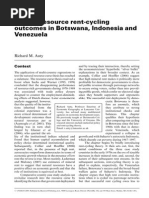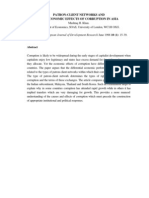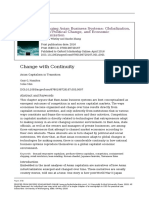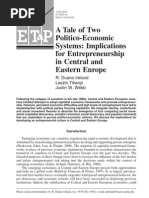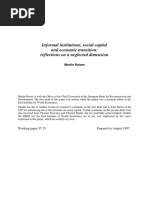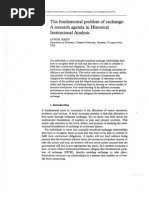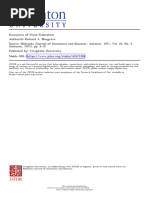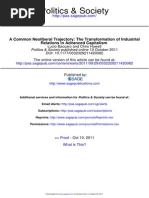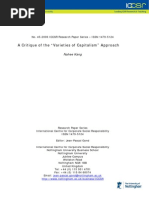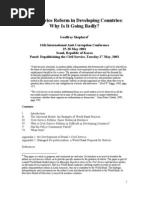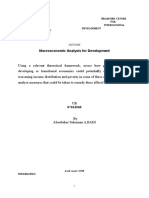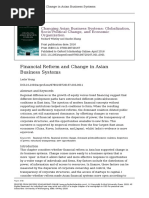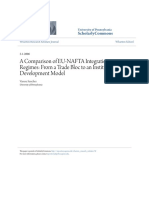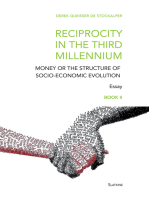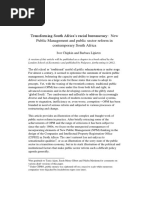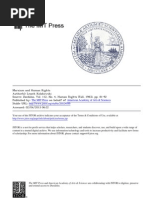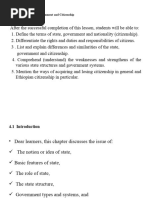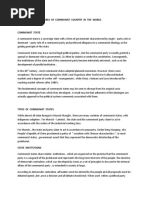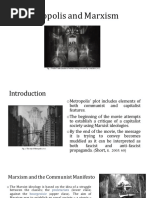2002 Rents Paper
2002 Rents Paper
Uploaded by
Adam FfordeCopyright:
Available Formats
2002 Rents Paper
2002 Rents Paper
Uploaded by
Adam FfordeCopyright
Available Formats
Share this document
Did you find this document useful?
Is this content inappropriate?
Copyright:
Available Formats
2002 Rents Paper
2002 Rents Paper
Uploaded by
Adam FfordeCopyright:
Available Formats
Post-Communist Economies, Vol. 14, No.
2, 2002
Resourcing Conservative Transition in Vietnam: Rent Switching and Resource Appropriation
ADAM FFORDE Abstract This article applies a novel approach to analysis of the transition to the market economy in Vietnam, a country with a political economy that draws upon South-East Asian, Sinic and Leninist cultural elements. This was a conservative transition, in the sense that no shift in political regime occurred. Understanding transition as a process where endogenous forces drive and resource institutional change, and far from dependent upon policy shifts, the article argues that it relied heavily upon two sets of phenomena. The rst may be understood in terms of the creation and seeking out of economic rents, in the neoclassical sense of resources available below economic costs. When rents result from institutional obstacles to competition, institutional change can support relatively costless output gains. I argue for Vietnam that as the economic system switched from plan to market, so rent seeking shifted away from advantageous access to resources for plan implementation, to switching resources into forms that supported market-oriented activity. This rent switching (RS) relied upon adaptive social relations, comparable to the competitive clientelism of the SEA studies literature, that were preserved and augmented during transition. It also permitted mobilisation of resources derived from static ef ciency gains. This framework contrasts with a second, more classical in nature, that concentrates upon the creation of appropriable resources (ARs) and contestation over them. These help explain the medium and longer term, and how ways of appropriating resources supported the political economy of systemic change. At root, this is then to do with the emergence of factor markets (land, labour and capital), class formation and thus broader social and cultural change. The article thus argues
Adam Fforde, Melbourne, Australia. This article was presented in part and in an earlier draft form at the conference on Rents and Development in Southeast Asia held at the Institute of Advanced Studies, University of Malaya, Kuala Lumpur on 2728 August 1996, and thanks are owed to the organisers, especially Mushtaq Khan and K. S. Jomo. Recognition is due to the following academic funding organisations: ESRC (UKPhD and Post-Doc), ARC (AustraliaLarge Research Grant), NCDS (ANUVisiting Fellowship), Stockholm School of Economics (Visiting Fellowship) and the Department of Economics, RSPAS ANU (Visiting Fellowship), as well as the Dept of Political and Social Change, ANU (Visiting Fellowship). I would also like to acknowledge the stimulating multi-disciplinary environment at the National University of Singapore SEA Studies Programme, and especially discussions with Mike Montesano; colleagues at the Economics and Political and Social Change Departments at ANU; and David Marr and Melanie Beresford. Thanks also to participants in a seminar at the Economics Department of the University of Adelaide, and to readers of earlier drafts: Andrew MacIntyre, Wendy Carlin, Frederik Sjoholm, Gavin Peebles and Nguyen Trien. The mistakes remain mine.
ISSN 1463-1377 print/ISSN 1465-3958 online/02/020203-24 2002 Centre for Research into Post-Communist Economies DOI:10.1080/14631370220139927
204
Adam Fforde
that different economic theories provide useful insights into the social as well as the economic implications and nature of the transition to a market economy. Given that static ef ciency gains, whilst signi cant in relative impact, tend to act over the short term, and, since growth processes take decades, the neoclassical approach is ultimately less important than the classical one.
Introduction Overview: Analysis of Conservative Transition This article presents a novel approach to the analysis of transition, applying the concepts of rent switching and appropriable resources. This not only permits a more persuasive interpretation of Vietnams shift from plan to market but also provides a link between economic arguments, such as those of static economic ef ciency that underlie rent theory, and political and social issues, such as appropriation and class formation, and the use of state power by social networks to create rents in different ways as the economy evolves. This approach is used to discuss the example of Vietnam, a case of successful transition if criteria of economic growth, poverty reduction and political stability are to be used, yet with ongoing problems of corruption and weak democratisation. The discussion situates rents within explanations of Vietnamese postreuni cation history. The concept plays two roles. First, it permits us to apply rigorously the standard and traditional neoclassical analysis of situations where competition cannot compete away advantage due to institutional issues. It reminds us that there can be signi cant static ef ciency gains when institutions change. Second, and more pro tably in looking at process, it provides us with the related notion of rent switching (RSsee below), which focuses our attention upon sets of strategies, different for each stage in the process, undertaken to change institutions in order to create advantage, ie different forms of rent seeking. Underpinning this is the robust notion that systems can and do change but human relationships change slowly, that is, that Vietnams cultural and national histories inform the transition history, just as ideas of clientelism inform much of the regions history. And, intriguingly, just as the concept of competitive clientelism when applied to Thailand confounds orthodox arguments about the growth-damaging effects of corruption, so we nd Vietnamese economic growth usually far faster, despite the muddle and corruption, than is expected.1 The details of state-business relations in Vietnam are murky and we are well behind others in research work. Yet the overall picture starts to become clearer.2 Whether classical, neoclassical or whatever, economics as a discipline focuses upon the analysis and evaluation of structured social con gurations de ned in various ways, which usually come down in the end to systems. Vietnam, apparently centrally planned for many years prior to 198990, offers in modern historical sequence four economic systems: ICentrally planned, IIPure Transitional (within which plan and market legally coexist),3 IIIPost-transitional (a period of primary accumulation within which normal social institutions and classes appear to be forming), and IVsome Final system that could bear the adjective modernising, if only to follow the practices of the Vietnamese Communist Party, which de nes present national tasks as modernisation and industrialisation. A historical periodisation (discussed further below) is as follows. Iup to 1981
Conservative Transition in Vietnam
205
and the partial reforms (Decree 25-CP) that legalised SOE involvement in markets; IIup to 198990 and the extinction of the Three PlanTwo Price system; IIIup to around 19992000, when the private sector started to emerge with vigour and, in the aftermath of the hangover from the mid-1990s boom, state-SOE relations started to become recognisably developmental as Zysmanian process started to re-harden budget constraints;4 IVfrom around 2000. These various systems can be de ned in various ways to suit the audience and/or the prejudices of the analyst. That they occurred sequentially entices analysis of their internal dysfunctionalitywhy they did not persist. This returns us to the question of how local incentive structures both encouraged and resourced endogenous systemic change. On the one hand is the question of incentive structure (relative returns); on the other lies that of the resources associated with systemic change. Conceptualising Incentive StructuresRents and Appropriation Comparison here is made between two alternatives,5 rst, the concept of rent switching (RS). By this I mean the use of social networks to switch the form of intervention (i.e. rent creation) to maintain advantage as the economic system changes. Capacity to enhance static ef ciency by accessing rents created for the plan may, later on, be used to create new forms of rent with negative static effects. The concept of rent switching under transition may be illustrated by the following example, and made more vivid by reference to the London slang term a nice little earner. A group of gentlemen, secure in their position within local power structures such as the party and planning bodies, switches resources from a stateowned enterprise (SOE). These were procured from farmers in collectives, thus creating a rent intended for the plan, and appearing as high pro ts at SOEs. However, these can be and are acquired by these gentlemen, thus, at a very low cost compared with their value. They are then used to produce goods in a local artisanal cooperative, partly for sale on the free market, partly to nourish valuable networks through gifts. Economic ef ciency is improved, time goes on, and capital is accumulated under various forms and under the control of the group. Indeed, a nice little earner. The economic effects of this rent switching are to enhance static ef ciency. A second example of rent switching would then be as follows. Some years have passed, and it is now possible to use capital to develop a retail distribution system for sale of imported high-value consumer goods. The gentlemen can agree to liquidate capital in the artisanal cooperative, which is in any case now less pro table as farmers cannot be induced to meet procurement targets, and put it into the new business. Certainly, they will have every incentive to use their political power to hinder entry into this sector of competitors, such as groups whose import business could threaten their pro ts. The same gentlemen now rent switch by switching the creation and seeking of rents into new forms better suited to the transformed economic system. This tends to have negative effects upon static ef ciency. Rent switching, therefore, means the use of social networks to exploit rents, adapting to changing opportunities. Second, is the idea of appropriable resources (ARs). Clearly, the emergence of private property will entail appropriation of assets, and the appearance of classes. The notion of ARs points to the two central aspects of this processthat valuable resources exist, and that they be appropriable in some form or other. The important difference between ARs and rents lies in the economic impact, especially the presence or absence of static ef ciency changes. As we will see, rents
206
Adam Fforde
Table 1. Switchable rents and appropriable resources
Stage Switchable rents Very high High, falling Low Medium ARs Very low Medium, rising Very high Low
Up to 1980 198190 19902000 Since 2000
I (Pre-transition ) II (Pure transition) III (Primary accumulation ) IV (Normal accumulation )
may imply the existence of ARs, but they may not. Rents have static ef ciency implications, ARs may not. Rents may have implications for the resourcing of new institutions, through the utilisation of these ef ciency gains. ARs have far greater importance for economic dynamics. To return to our example: the gentlemen will almost certainly nd themselves in positions where they can simply appropriate resources. This may involve a reduction in rents, but it may not. Discussion requires further clari cation of just what we mean when we use the notion of rents under such conditions, but here consider for illustration idle landfor example, the spare warehouse of the original SOE, never used and basically forgotten. Until they realise that they can, through manipulation of the World Bank-funded land-titling project, acquire this, it creates no advantage to anybody, and so there is no rent to speak of. Yet, a decade later, it appears as the jewel in the crown, prime real estate owned by the gentlemen, who are now operating under various guises, including property development. The land was valuable, appropriable and a resource. These concepts can be related to the changing characteristics of the Vietnamese economy, as summarised in Table 1, which presents a simple summary of the changing signi cance of switchable rents and ARs in recent Vietnamese history.6 Pure Transition, its Origins and Resourcing: the Vietnamese Economy before Reuni cation and Continuities with the 1980s Introduction: Analysis of the Vietnamese Transition Vietnamese economic development since reuni cation in 1975 reveals clearly the value of analysing change in terms of rents, rent switching and the generation and appropriation of valuable appropriable resources (ARs). Furthermore, equally visible is the importance to commercial interests of relations with elements of the state apparatus, and vice versa, and so the motivation to switch, create (or curb) rents and ARs.7 And one can also trace the effects upon this of the introduction of of cials and senior party members, early in the 1990s, to the possibilities offered by modern developmentalist techniques of rule, such as the use of a tax base and state treasury, and state banks, to channel resources to SOE-focused development at local and national levels (Fforde, 1997). The sequencing of transition in Vietnam, and of the policy changes associated with it, is rather different from that of the most immediate point of comparison, China (Fforde, 1999). The relative failure of central planning in Vietnam compared with China meant that a far lower share of output was being invested prior to liberalisation. At the start of pure transition the Vietnamese state therefore controlled a far lower proportion of economic activity, since these high savings were mainly controlled by the state. This is understandable in terms of Vietnams history.
Conservative Transition in Vietnam
The Pre-1975 Situation
207
Prior to national uni cation in 197576 communist policies were implemented through state structures only in the norththe Democratic Republic of Vietnam (the DRV). Thus the party found itself attempting forced industrialisation in an area of over-population and minimal agrarian surplus. Basic ground rules, in terms of the political economy, were well established early on as the DRV attempted relatively normal neo-Stalinist transformations and development prior to the onset of the US air war in 196465.8 For various reasons, a widening gap between free market and state prices emerged around 196263, and the resulting diversion of effort to free market activities, although frowned upon, was not met with the standard Stalinist violence. By then, farming families had joined agricultural producer cooperatives, large-scale industry had been made subject to central planning, petty producers either closed down or brought into cooperatives and so forth. By around 1964 the share of consumer goods in the large programme of foreign aid was rising.9 Debates over the general applicability of the neo-Stalinist programme in the area occurred around 1964, but resulted in defeat for reformers and support for the continuing attempt to make the system work. At that time there was already evidence of a certain recognisable degree of spontaneous marketisation. At this time it was very costly to acquire economic resources that could be used in marketsideological pressures were too high and it was therefore too risky. There were therefore few ARs, and little endogenous accumulation. Yet switchable rents were also very high, since the planning system was relatively strong, in the sense of being able to enforce interventions that prevented competition removing advantage in the form of rents. Those lucky enough to acquire them could enjoy signi cant output gains locally through the operation of Kim Ngocs law.10 A second attempt at liberalising reform occurred in 196768 at a time of severe food shortage, heavy bombing and prior to large-scale food aid. Trials with household contracting within the agricultural producer cooperatives, although initially tolerated at peak leadership level, later met with criticism and were formally abandoned. 11 However, at no time during this period was there any policy of severe pressure against rural markets, and there is some evidence for a de facto laissezfaire attitude within the overall parameters set by the norms of the modi ed neo-Stalinist system during wartime.12 Policy Problems in the North just Prior to Reuni cation In the early 1970s, prior to reuni cation, policy reform clearly showed awareness of considerable de facto laissez-faire that allowed widespread non-compliance with plan norms. Reforms in this conservative13 sense can be seen in three areas. These all pointed to possible sites for rent acquisition, and also for accumulation-boosting ARs should conditions change. First, in agriculture, there was an attempt to place farming families under stronger control, with stricter limits on family plot activities; cooperatives were increased in size and brought under the district planning level. Formalised as a New Management System at the Thai Binh conference in 1974,14 this de ned rural policy goals on the eve of national reuni cation as actively anti-market and opposed to family farm autonomy, suggesting that the underlying aim was to reverse the consequences of wartime laissez-faire.
208
Adam Fforde
Second, in the area of SOEs and central planning reform was also conservative, and addressed criticisms of confusion and waste, proposing and adopting policies familiar from Eastern Europe involving better incentive structures (the three funds system), closer and more effective planning procedures and enhanced discipline.15 Third, however, policy granted small-scale industry in cooperatives freedom to procure resources in a direct and quasi-market manner, subject to constraints regarding respect for obligations to supply goods at state prices to the state planning system. This policy stance suggests that the development programme in the reunited country after 1975 had in fact two parts: a strengthening and enhanced implementation of established but frequently violated norms in the north, and application of the existing, and weak, northern system to the south. However, by 1975 both north and south Vietnam were heavily aid dependent. In terms of rent creation and ARs, this had important implications: major shocks to the political economy would occur if external assistance levels were to change abruptly.16 The Origins of Liberalisation and Reform Economic liberalisation as policy change should in any signi cant sense be dated to the 6th plenum of the IV Party Central Committee, held in September 1979 in the aftermath of the loss of Western and Chinese aid, Vietnams joining of COMECON and armed con ict between Vietnam and China.17 This meant that the incentive structures facing SOEs and agricultural cooperatives changed fundamentally, and processes were set in train that drove the commercialisation of the economy from below. Policy followed these underlying fault lines.18 What were these processes? At root, they were a mixture of static, ef ciency-enhancing switching of rents, linked to increasing competition, with the gradual emergence of ways of accessing ARs that created a stable basis for market-oriented accumulation. The Vietnamese Transition: Rent Switching, Appropriable Resources and the Continuities before and after Reuni cation Central here is the shift from a neo-Stalinist pattern of economic growth and social differentiation (accumulation19 and class formation) to one historically more appropriate to a society and economy where markets dominate economic transactions. The neo-Stalinist system created strong distortions to the macroeconomy, intending that the state would use these resources to focus upon investment in priority areas. This process relied heavily upon the use of state in uence over SOEs and agricultural cooperatives used as mechanisms for appropriating resources and then delivering them to the plan at low xed state prices. It is important to note that the plan had two aspects to it: a plan of production and a plan of distribution. SOEs and agricultural cooperatives were under pressure to supply to the state, and to produce the planned output level with inputs delivered by the state. The states ability to control distribution of products was therefore crucial, since this permitted it to in uence the terms of trade facing various producers. A typical example of this would be the delivery of agricultural products at low prices that could then be used to supply rations to state industrial workers, thus keeping down industrial costs. Yet within SOEs and agricultural cooperatives the plan had far less impact than outside themthe output plan was far less implementable than the distribution plan;
Conservative Transition in Vietnam
209
planners, for all the sound and fury, had to admit to the negotiated nature of outcomes within SOEs and cooperatives. Outside them, however, things were rather different, and the state spent much time and effort maintaining the distributional relations within the economy, and thereby the particular pattern of terms of trade that ensured that SOEs made large pro ts to create investable surpluses. Applications of violence, it can be observed, were typically against free marketeers and those who wished to avoid joining such socialist institutions. Rents arose, thus, in part from the limits placed upon competition. From this perspective there is, in the question of rents, rent switching and ARs, a clear commonality between the economic systems before, during and after the transition to a market economy. It is probable that switchable rents would have been very high in Stage I prior to the introduction of partial reforms (in 198081), due to the distortions created by the as yet largely unliberalised central planning system. On the other hand, ARs would have been very low, mainly because of the authorities willingness and capacity to use standard neo-Stalinist anti-free market measures. This situation high switchable rents, low ARs ts with the basic reality of a neo-Stalinist systemlimited but very pro table black and parallel markets.20 These markets arose from the successful capture of rents within the central planning system. The old system had at its core the creation of economic rents through central planning. A combination of the institutions of the neo-Stalinist programme and the way in which the administrative prices of the plan were set enabled the system to create economic rents (or surpluses) that were used to support a pattern of accumulation based upon the state sector. SOEs were the sites of large-scale pro t generation, and of the massive ows of investment resources for socialist industrialisation. Socially, both their cadres and their workers were at the top of the food chain, receiving considerable social prestige and material privileges. Yet some of these rents were contestable and could be captured by local interests, and then switched to resource other activities. ARs could resource accumulation of productive assets that were more locally controlled, and relatively autonomous. If still within SOEs, these were typically referred to by such terms as own plan activities; if outside them, they would take the form of businesses subject to groups that controlled the relatively autonomous capital within SOEs.21 But until extra-plan activities were legalised by the partial reforms, ARs were simply very risky to appropriate. It is the reality of negotiation within the basic units of the neo-Stalinist system that offered scope for relatively autonomous accumulation based upon ARs, often themselves created by successful contestation over rents that led to static ef ciency gains from endogenous pro-market and competition-based institutional change. Once SOEs and/or cooperatives engaged in relatively free exchange of outputs and obtained inputs relatively freely, they were able to accumulate capital under their own control.22 And Kim Ngocs law was a vital push to this process in its early stages. Thus the argument is that once neo-Stalinist systems start to liberalise, producers (often within the planned system) accumulate capital outside the planning system.23 They operate in an environment full of opportunities for making high pro ts created by the planning system itself. Successful neo-Stalinist economies usually created very high levels of savings, which supported periods of very rapid growth despite high economic inef ciency. These savings come from the imposition through the plan of terms of trade that channelled resources through the state to nance
210
Adam Fforde
industrial investment. It is precisely because these rents are so high (the ARs are so valuable) that there is so much pork available for SOEs and others when and if they can access it for local relatively autonomous accumulation and moneymaking. And it was this that Vietnams partial reforms of 1981 permitted. If we turn the picture around, therefore, such an economy can thus be seen as being full of switchable rents and appropriable resources. These are not just, as in many historical contexts, the property of groups from whom it can be taken, but are bound up with rents in the neoclassical sense. This means that their appropriation can also involve very sharp increases in output from static ef ciency gains. Because of the speci c nature of a centrally planned economy, ARs and rents can thus act together to resource and incentivise endogenous liberalisation. From this perspective, the extent of levels of violence and repression required to defend socialist property is not surprising. In Stage II, Pure Transition, these resources are the basis for accumulation of capital outside the plan. During Stage II of the Vietnamese transition, therefore, as presented in Table 1, rents remained high, although falling sharply as economic organisation became less inef cient in a static sense. ARs, on the other hand, became larger. Two reasons for this were, rst, the rising tendency for resources to become capitalised as incomes rose (especially in SOEs) and workers subsistence needs became less critical, and second, as the transition became entrenched, the rapid decline in the risks associated with what could easily be said to be the theft of state property.24 Bribery became more institutionalised and effective, and as of cials saw a changing future for them and their families, primary accumulation saw a far less vigorous use of the security forces. Thus, by the end of the 1980s the approaching end of pure transition meant that few opportunities remained to enjoy static ef ciency gains. Thus the transition process had already largely consumed one source of resources for growththe static inef ciencies of the planned economy itself. After the decade of pure transition in the 1980s the Vietnamese economy was thus very different from others as they also shifted to generalised production for markets rather than planners. It was more market-oriented, exible and far less subject to the distortions that made it so hard for other more developed socialist economies to shift across to generalised market-oriented economic activity if they were unlucky enough to attempt Big Bang policies.25 Also, the increasing importance of ARs pointed to the future emergence of factor markets. It is the profound extent of commercialisation of the Vietnamese state sector that explains the surprising resilience of output during the period 198990, when Soviet aid was lost and the state sector cut off from access to economic support. Primary Accumulation: the Vietnamese Market Economy of the 1990s Basic Characteristics The economy that emerged in Vietnam during 198990 was certainly an economy dominated by production for the market. It was a commodity economy, in any normal sense of the phrase, and should thus be de ned as a market economy. However, it was not an economy where factors of production were yet acquired on easily identi able markets. For some, the absence of obvious factor marketsso that land, capital and labour are all acquired as commodities, with clear prices and supply and demand in operationwould suggest that the Vietnamese economy in the period immediately
Conservative Transition in Vietnam
211
after 1989 was not a market economy. They would argue that across a wide range of producers, who were selling commodities of various sorts onto markets of various types, neither labour nor capital nor land were acquired as commodities. Crucially, those economic organisations that had been the core institutions of the traditional socialist model, and which had become increasingly involved in market activities through the pure transition 1980s, were not acquiring factors of production through markets. For SOEs, land used by them had been allocated through the central planning system; they paid no rents, and could not simply buy or sell it; labour was, predominantly, still based upon the allocation of workers by the traditional labour control systembut extensive bonus and quasi-bonus methods had arisen; and capital had predominantly either been acquired through retention of business earnings or allocations from the planning system under various guisesvarious forms of joint venture had occurred but these were still limited. For agricultural cooperatives and farmers the situation was still very much in a state of ux. Decree No. 10 in 1988 had greatly reduced the power of cooperatives over farming families, and a process of decollectivisation set in train. Yet agrarian incomes growth had not started to accelerate. If we look at factor markets, land was still formally owned by the state and use-rights held by cooperatives;26 labour could be acquired in various ways, but largely remained family labour; capital was either based upon various family level activities carried out through the 1980s or earlier, or upon the increasing access to cooperative resources as they were sold off or hired out, or upon the beginnings of inter-family lendingformal bank credit was insigni cant.27 For the remaining key element of the traditional and pure transitional economiesthe state trading networkretained earnings were far more important. In addition, it should be mentioned that the emergent nominally private sector outside agriculture remained small, and was still largely focused upon trade. The opening of the countrys borders to relatively free trade in 1989 had had a heavy impact upon this sector. A Market Economy without Factor Markets and Class Formation For what was to follow, I think that the key aspect of the Vietnamese economy in 198990 was the combination of generalisedif not universaluse of markets to acquire and dispose of inputs and outputs with weakly developed factor markets. Vietnams annual economic growth rate in the 1990s prior to the 1997 Asian Crisis, which averaged well over 6% per capita, was closely bound up with the interaction between the commercial purchase of inputs and sales of output, to make pro ts, and the development of ways of acquiring the factors of production needed to do so. Thus, if a slogan is sought, if the 1980s were From Plan to Market, the 1990s were From Market to Class. And in this the emergence of a recognisable and stable property rights regime suited to a market economy (in ways that were not present in 198990) would require not only the emergence of clear classes but also some system of state and societal governance.28 And, in turn, this pointed to central political and social issues of the decade after 2000. Crucially, factors of production would no longer be acquired through the various non-market methods of the traditional economic system, or the quasi-market methods of the pure transition with its focus upon accumulation within SOEs. Rather, they would occur through new methods within which they were increasingly themselves
212
Adam Fforde
commodities with the normal characteristics of commodities. That is, that they had a price, owners and the ability to be bought and sold on markets. Factors of production would thus need to be appropriated (to have owners), to be priced, to be sold and to be purchased. Strange as it may seem, but in fact of crucial importance to any understanding of these processes, prior to that process factors of production were not commodities, they were therefore not owned in the same sense as commodities are, nor were they priced and those prices related to supply and demand through being bought and sold. Switchable Rents, ARs, the Emergence of Factor Markets and State Practice in the 1990s Unlike China, there was a marked lack of new entrants to Vietnamese commercial activities in the market economy of the early and mid-1990s.29 The most important were foreign companies, initially in joint ventures with SOEs, and increasingly, after the 1997 Asian Crisis, as 100% foreign-owned investments. Vietnamese outsiders, however, whilst coming onto the scene, were not great in number.30 Vietnamese business, as it emerged in the early 1990s, was mainly made up of SOEs and had evolved in an environment pervaded by large and state-created rents of particular types. Commerce and trade were predominantly carried out by a commercialised state sector, used to negotiating resource access through relations between of cials in SOEs and of cials elsewhere. As I have discussed, rents had originally been created by the neo-Stalinist system, but had then become a central element of processes of relatively autonomous accumulation within the basic institutions of the socialist economySOEs and agricultural cooperatives. However, it was in the former that pro ts and growth were signi cant, and this was mainly for historical reasons. Two factors in particular had played an important role. First, under central planning the Vietnamese economy was not, during the late 1970s, generating suf cient levels of savings to allow the state to shift resources towards a signi cant improvement in the terms of trade facing farming families, so that substantial increases in rural incomes did not occur until the early 1990s. Rural incomes in Vietnam did not start to grow signi cantly until late in the process around 198889, after Decree No. 10 of the Politburo (1988)and accompanied a liberalisation of exports and robust growth in domestic markets. Early agrarian reform (Decree CT-100 in January 1981) was not followed by any sustained improvement in rural incomes although output jumped in the two years after the reform was promulgated. Between 1978 and 1984 agricultural output rose 48%; crucially, staples output per capita stagnated from around 1982. In China, however, agricultural growth accelerated in 1979, growing some 55% between 1978 and 1984. 31 Staples output per capita rose by nearly one quarter. The origins of the Chinese rural growth spurt were at least in part due to state price changes; the Vietnamese counterpart had far less impact.32 It cannot be overemphasised that the lack of a buoyant rural economy in Vietnam until the mid-1990s has had profound impactthe absence of the Chinese TVE phenomenon, and a Vietnamese SOE sector that has a far more intimate relationship with local of cials, and is far more dependent upon bank credits and far less successful at nancing growth from retained pro ts. Second, SOE commercialisation started at the beginning of the 1980s and took place under conditions where ARs were signi cant but not substantial, so that they were rapidly eroded by the process of commercialisation itself. This meant that the
Conservative Transition in Vietnam
213
SOE sector as a whole was capable of enduring a relatively hard budget constraint when the market economy emerged in 198990. SOEs therefore lacked a major cushion at a crucial time in their commercial history. The overall nature of state-business relations in the very early 1990s therefore stood at a crossroads. The state sector was the dominant commercial form outside agriculture, with close political links. Accustomed as it was to rent switching and a rent-creating economy, it had nevertheless shown that it could survive (if it had to) without access to signi cant ARs or rents, and when subject to intense competition after Vietnams borders were opened in 1989. It is natural to argue that for such a society, with a political culture used to hierarchies and communities within which feeding played important roles, other forms of rent creationsuggesting likely creation of ARswould arise.33 And, as state resources recovered in the early 1990s, this was precisely what happened.34 The nature of the Vietnamese economy in 198990, and especially the lack of factor markets, was to have a major impact upon the creation and use of rents after 198990. The lack of a capital market had important implications for the treatment of external funding of SOEs. Meanwhile, however, emergence of a land market would create important opportunities for pro t. The 1990s and Primary Accumulation If the notion of rent switching re ects reality, then the key role played by SOEs in the growth of the Vietnamese economy since 198990 makes it very pertinent to ask what happened to rent switching and ARs through the 1990s. How was this translated into policies designed to favour particular areas through the encouragement of AR and rent-seeking behaviour? The next sections examine important aspects of this issue. First, granted the historical fact that central planning largely failed in Vietnam, in large part due to successful switching of rents, what happened to state resources through the 1990s? Second, what did macroeconomic conditions imply for the availability of ARs and rents? Third, what were the implications of the emergence of factor markets markets for land and labour in particular? The Changing Level of Resources Available to the State It is certain, rst, that by the mid-1990s the resources available to the state had increased out of all proportion compared with the early 1990s (see Table 2), and that state policy increasingly tended to operate through direct targeted support in the context of an import substitution process that was highly export oriented. This appears consistent with the integration of Vietnams economy into globalisation processes within the region and is far from usual.35 Macroeconomic Stability, the State-Business Relationship and Factor Markets Rapid Growth and the Rising Reported State Share of GDP. A key but perhaps chimerical paradox of the growth process in Vietnam in the 1990s was the combination of an increasing share of total output produced by the state sector with general macroeconomic stability. The macroeconomy evolved in a way that provoked the approval of Bretton Woods institutions, and was characterised by a lack of the major distortions that are the subject of frequent criticism.36 The list is striking. The
214
Adam Fforde
Table 2. Resources subject to state in uence (US$ billion)
1990 Tax revenues Foreign trade taxes Bank credit outstandin g FDI disbursement s ODA Real state investment 1.1 0.1 1.0 0.1 0.1a 0.4 1994 3.8 0.9 2.6 0.6 0.4 1.0
Note: a 1991. Source: Vietnam: Economic Commentary and Analysis 7, ADUKI Pty Ltd Canberra, 1995, p. 341.
exchange rate had been uni ed, with no real gap between of cial and free market rates. Interest rates were positive in real terms to borrowers and lenders, and from 1992 SOEs received no direct subsidy from the state in terms of an inverted interest rate structure. Prices were generally stable. Direct subsidies from the budget to the state sector were cut back to very low levels (net transfers to the budget from SOEs were around 12% of GDP in 1994).37 There were no signi cant subsidies to wage goods. The banking system offered depositors relatively liquid dollar deposits at rates close to LIBOR, and rather lower than those offered on Vietnamese dong. Between one third and a half of total banking sector liabilities were in foreign currency. This suggests that the general population retained con dence in the banking system, at rather low cost in terms of payment of risk premia by the authorities. 38 The Nature of SOEs and the Process of Change: Factor Markets and ARs. A common argument used to explain the relative success of SOEs under such conditions has been to point to the effects upon their ownership structures of the history of the 1980s, and to argue that their private character was high. Incentive structures facing managers, the substantial labour sharing since the late 1980s and the high levels of competition in product markets support the argument that the typical Vietnamese SOE of the early 1990s, if it survived and was generating positive cash ow (as the sector did in fact do), was treated by the forces that in reality owned it as something close to a capitalist business. Thus, ARs had been effectively capitalised, and appropriated as such. How true, though, is this picture? Certainly, it was not supported by most Vietnamese and foreign economists for whom the picture of state ownership sensu stricto remained. More research is badly needed here. Here also the consequences of the emergence of factor markets need spelling out. 39 These arguably added to a picture within which SOEs need to be seen as far more commercial than state in character. Land and Land Markets. In Vietnam land, according to the Constitution, continued to belong to the whole people. However, there was considerable success in developing effective transferable land use rights, so that land access could in effect be bought and sold.40 However, and this was especially true for urban land, the commoditisation of land use rights created enormous transitionary economic rents (ARs), which were manifest in two main ways:
Conservative Transition in Vietnam
215
First, in the allocation of land to individuals, usually through their state organisations, which could then either be used for construction of a dwelling for their own use or sold on. Land prices in Hanoi and Ho Chi Minh had risen by the late 1990s to levels comparable to those in countries with far higher per capita GDPs. Second, in use by SOEs as their share of capital needed to found joint ventures with foreign businesses. If it is appreciated that until the late 1980s almost no land in the main urban areas possessed monetised exchange value, and that half a decade later the process of commoditisation in these two large cities was almost over, then the size of the ARs generated was clearly vast.41 The importance of commoditisation is most easily seen in the case of land. For capital and labour, the picture is not so clear. Capital Markets. There are two key questions when discussing the emergence of capital markets in Vietnam during the 1990s. These relate to their origins, and the depth and extent of informal capital markets centred upon SOEs by the end of the 1980s. The rst question concerns the extent to which SOEs had bene ted during the 1980s from reinvestment within their safe shells of funds accumulated elsewhere, for example through black market deals or work in Eastern Europe. Here one should recall that the private sector was only ideologically accepted in 198788, and after experiences of policy reversals in the early 1980s the public exercised great caution in its investment decisions until the early 1990s. As a consequence, interests controlling SOEs bene ted not only from ARs but also from inward investments. The second question is to what extent SOE capital structures were commercialised and diverse by 1989. There is certain anecdotal evidence to suggest that, partly because of the length of time that had passed since the commercialisation process had been accepted by policy in 1981, SOEs were often well familiar with markets, deals and joint ventures by the end of decade. Associated with this picture is the notion that the private nature of SOEs increased, with their effective appropriation by various forces and groups; these included managers as well as individuals within their superior agencies. It is certainly striking how the trend in the mid-1990s toward the establishment of state groups and corporations permitted interests above SOEs to continue to act as their part-owners (see Appendix 1). The state corporations that emerged in the mid-1990s appear designed, among other things, to preserve agglomerations of state capital previously organised under different forms. By 199596 they were less formally dependent upon line ministries than before. However, the key individuals and relationships (for example, with local authorities) were given an opportunity to survive through their representation on the management board. The right to move capital around between the SOEs that make up a General Company is a pertinent comment upon how their ownership is viewed (see Appendix 1).42 Thus there remains a key research question, which is at root to do with the nature of the Vietnamese capital market. What does seem true, though, is that the rapid rates of growth were occurring without much in the way of formal and recorded intermediation, pointing to a deep informal capital market. What is not known is the extent to which the increased investment rates were funded from retained earnings. Two elements of the capital market remained subject to state in uence: bank credit and access to FDI, which by the mid-1990s, just before the Asian Crisis, was
216
Adam Fforde
amounting to perhaps one-third of total investment. Although hard evidence is dif cult to nd, most bank credit came through state commercial banks in accordance with credit allocation priorities that were the counterpart of the way in which lending rates were set well below those that would clear supply and demand for credit. Deposit rates had to be kept high, as con dence in the value of Vietnamese dong deposits recovered from the experience of past hyperin ation and socialist transformation. This meant that lending rates also had to be high, although the net effect was to increase transaction costs and keep lending rates down, since it took a while for non-state banks to grow, and so the state banking system was able to exploit its position to take a high share of deposits. Interest rates remained xed by the State Bank. However, there was a clear trend to a reduction in the extent to which credit was channelled to SOEs. Labour Markets. By comparison with the land and capital markets, the labour market was relatively straightforward. An early acceptance on ideological grounds that labour was a commodity to be bought and sold re ected the rapid growth of employment in the rst half of the 1990s, which more than offset job losses in the state sector (Tran The Duong, 1994). Direct state subsidies were rapidly reduced, helped by the way in which wages paid had, by the end of the 1980s, already divided into a certain minimum based upon state norms and bonuses dependent upon pro tability. The element of these bonuses that was due to pro t sharing appears to have declined quickly, so that wages by the mid-1990s largely re ected supply and demand. Arguably, rent switching saw workers pro t shares moved into the pro ts of those who controlled SOEs.
Primary Accumulation, Factor Markets and Class Formation: Conclusions During the 1990s factor markets and classes clearly start to come into view. Rent switching, in the neoclassical sense, no longer contributes much to short-run output gains. Rather, the growth pattern is one of consolidation, with important appropriation practices bolstering the emergence of a more normal market-oriented political economy. The most striking area where ARs supported accumulation in the 1990s was the land market. The second was the important changes in the property rights regime linking SOEs, managers, of cials and formal state regulation; more concretely, who controlled them, and who bene ted from their pro ts. This was deeply bound up with the social relationships that had underpinned rent switching.43
Analytical ImplicationsRent Switching or ARs? The 1990s were clearly a period of class formation and asset appropriation. Thus in Table 1 ARs contrast with the trajectory of rent switching, for through the 1980s most obvious rents associated with the neo-Stalinist system had been competed away. Note that the general macroeconomic stability of the period reduced rent creation. The most important source of temporary ARs was to do with the emergence of a land market, and this did not have much major effect upon static economic ef ciency. The effect upon class formation, however, was far more dramatic. It
Conservative Transition in Vietnam
217
tended to create a situation where, on the one hand, SOEs were increasingly owned, with good earnings only available to established members of the groups that controlled them, whilst, on the other hand, middle-class families were increasingly aware of the value of their assets and the need, if they were not part of the SOE-owning group, to nd ways of generating revenues from them. Thus, as earnings from SOEs sought more private outlets, outsiders also drove the emergence of the private sector. Both, of course, faced barriers from the interventions put in place by successful rent switching behaviour. Yet in many market economies such issues are quite normal. Just as competitive clientelism suggested, for Thailand, that corruption could co-exist with rapid growth (so long as the state organs responsible for macroeconomic stability remained inviolate) (Doner & Ramsay, 1997), so Vietnams historical experience suggests that it will be hard to maintain arti cial barriers to entrepreneurship for too long.
Conclusions Rents, rent switching and ARs offer insights into the emergence and development of the Vietnamese market economy. The former present a shortcoming in their lack of measurabilitythey point to signi cant effects, but it is hard to see how signi cant. My opinion would be that they are signi cant at crucial stages in the process, but then far less important than ARs, where powerful evidence from macroeconomic statistics can be simply related to the discussion, thus increasing the persuasive power of the argument. This relates also to the essentially comparative static basis of rent theory, where even estimates of the calculated value of ef ciency gains based upon computer modelling are placed out of Pareto context, and so in abstraction from the brutal political economy of systemic changekto kogo?, who wins?in the Leninist formulation.44 Since 198990, however, as well as before, it is important to distinguish between transitionary and other types of ARs. It is also useful to look at processes of rent creation and the role played by rent switching. There is some evidence for the re-emergence during the 1990s of systemic rent creation in what has in modern times been a highly rent-sensitive society. It is not yet clear just what effect this will have upon accumulation. It is useful to recall here that the emergence of the market-oriented state businesses that survived the holocaust of the early 1990s took place in an environment saturated with rents. This suggests that in Vietnam, as perhaps elsewhere, there is an important difference at the micro level between seeking rents and using them. The openness of the Vietnamese economy, its general weakness and the apparent cultural and social tendency towards use of rents for commercial purposes rather than conspicuous consumption argue that caution should be maintained in going from the conclusion that processes of rent creation have been returning to one that would assert that growth rates would slow as a result. Much will depend, of course, on the ability to keep up domestic saving rates and also to avoid macroeconomic and institutional distortions that inhibit growth. This is to avoid addressing the vital set of issues to do with the effects upon the quality of growth and development of such economic trends, and speci cally extensive rent seeking and rent creation Finally, with class formation increasingly well established, the period after 2000 looks likely to be one where state intervention once again seeks to impose inef ciencies upon markets, in the name of development. This will increase rents.
218
Adam Fforde
However, ARs remain low. Much will therefore depend upon the extent to which business and state intervention combine to create a competitive basis for Vietnams further globalisation. The extent to which the gains from this are shared equitably or not will depend upon a wide range of factors. At a different level, it would seem clear that Vietnams prospects depend greatly upon her political economy, and within that upon the relationship between business and government. Here the experience of other South-East Asian countries has much to offer, not much of it good. For Vietnam, as a latecomer, lacking the vast past investments in export-oriented growth of her competitors, generating adequate production of those public goods and other elements of successful exporting will require great ef ciency. Whether hands-on or hands-off, government will be important, and in this a realistic assessment of where the economy is coming from requires attention to core issues addressed in this article. These include the real ownership of SOEs, for they clearly are not really state-owned, and also the great uncertainties presented by any attempt to direct the economy through intervention, since history shows that Vietnamese economic behaviour will seek out and acquire for local bene t anything that is valuable and appropriable. This can be good, it can be bad, but it is a characteristic. The research implications of this are clear. There is a need to examine the real relationships that exist between state and business; how SOEs are owned and controlled, and how rent switching is seen and carried out. Central to this is the nature of the social networks and cultural logics that underpin interventions. The policy implications are relatively straightforward. Without a clear understanding of politics and economics, and their cultural and historical underpinnings, the real impact of the sorts of developmental measures outlined in the Appendices will be impossible to assess.
Appendix 1 State Property and the Ownership of SOEs: Creation of Aspects of Rent Switching and ARs The 1995 Draft Statute on State Corporations45 (Dieu le mau) contains the following intriguing points, which suggest that the degree of de facto privatisation of SOEs was high, helping to explain in part their commercial power and success: Clause 2 refers to the issue of voluntary participation by SOEs in such corporations. Under normal circumstances, for example in Western Europe, it is unlikely that state corporations would be granted any true autonomy in such decisions. With formal control in the hands of the state as owner, the state would decide. Clause 6.4 states that the corporation has the right to transfer and cede, replace, rent out, use as collateral or lodge assets subject to its management. Clause 7.6 refers to the rights of the corporation to decide upon markets and establish an allocation of markets between its members; and Clause 7.6, its rights to decide upon the price frame or the purchase and selling prices of materials, raw materials, products, main services, minimum export prices and maximum import prices, apart from those products and services for which the state xes prices.
Conservative Transition in Vietnam
219
Clause 9 states that the corporation has the right to refuse and denounce any request for supply of resources not stipulated in law. Clause 11.4 states that the corporation must implement price stabilisation for prices of essential goods and services. Chapter III refers to the management boardthis contains no statement whatsoever about ownership. Clause 8.d does state, however, that when discussing issues of importance to the local authority, the board must invite a representative of the Peoples Committee at province level to the meeting. Clause 23.2.e is the most interesting. It states that the management board and the general manager of the corporation have the right to shift (dieu hoa)46 nancial resources, including foreign exchange, between members of the corporation in order to use capital most effectively in the corporation. The term shift here is very particular, and refers to the presence of a business entity above the SOE with rights to remove capital from itin other words, some sort of holding company, but with no clearly de ned ownership relationship with its members.
Appendix 2 State Rent Creation, Rent Switching or Creation of ARs? An Example from the mid-1990s Resolution of the Council of Ministers No. 20 CP xing details in the implementation of the Law to Stimulate Domestic Investment, 12 May 1995. Sectors eligible for investment support: 1. Forestation and planting of long-term crops on unused land, bare land and bare hills and mountains. 2. Investment in the technical infrastructure; development of urban public transport; development of education, training, health, ethnic minority culture, scienti c and technical research. 3. Processing of agricultural, forestry and marine products, and of services directly serving agriculture, forestry and sheries. 4. Production of exports. 5. Other industrial sectors targeted for priority development in the period 1995 2000: (a) Consumer goods productiontextiles, leather goods, garments, household goods, paper, study means. (b) Metallurgy, electronics and information technologyproduction of equipment and machines to produce and process agricultural, forestry and marine products, and consumer goods; production of construction and mineral extraction equipment; boat building, for both sea and river transport; production of railway engines and carriages, and the assembly and production of motor vehicles; equipment for power lines and power transformers. (c) Production of materialsextraction of oil and gas; use of natural gas; extraction and processing of coal; iron smelting and steel production; non-ferrous metals; fertiliser; basic chemicals. (d) Traditional branches needing supportcarvings; inlay work; lacquer ware; rattan and bamboo work; carpets; ceramics; earthenware and silks.
220
Adam Fforde
Appendix 3 An Example of State Interventionary Philosophy in the mid-1990sthe Law to Stimulate Investment47 The 1995 Law to Stimulate Domestic Investment sought to supply subsidised resources to priority areas.48 Decision No. 29 (12 May 1995) reveals the direction of policy. It therefore provides a clear example where government policy sought to create opportunities for rent switching or ARs. First, the list of businesses eligible for support includes those owned by social and political organisations (Clause 1). By this is included those shadowy and ill-regulated operations set up by scienti c organisations, mass organisations, the party and so on. It also includes business organisations set up according to Decree No. 66 (2 March 1992) with so little capital that they were operating outside the usual legal framework. Second, overseas Vietnamese, whether of Vietnamese nationality or not, could choose whether to operate under this Law or the Foreign Investment Lawbut may not operate under both (Clause 2). Third, assistance came from the state budget in the form of subsidised medium and long-term credits through state programmes or projects. These projects obtained funds from the National Investment Support Fund, which could in turn seek funds from almost any source, foreign or domestic. The fund would operate as a legal entity that did not make pro ts but had to preserve its capital and cover management costs. In addition, certain additional forms of support were presented. Exporters in priority areas with signed contracts were to receive priority loans from the state commercial banks. If they lacked capital, then it was the responsibility of the State Bank to supply them with it (Clause 11). When price uctuations exceeded certain levels, then cheap credits would be supplied through the Price Stabilisation Fund. Apart from access to subsidised credits, a second proposed source of support was through tax breaks. These were available for the list of activities reproduced in Appendix 2. They focused upon investment in plants using modern technologies that would improve technological diffusion; use domestic raw materials; produce goods of export quality; raise the quality of traditional products; reduce environmental pollution; produce new materials; and use high levels of technology. The target sectors were clearly medium-sized businesses. The minimum scale was set in terms of workforce numbers: 300 in urban areas; 50 in mountain regions; 200 elsewhere. There were additional possibilities for businesses in remote and minority areas, and for those in dif cult zones. The details of tax breaks stated that businesses must have been newly set up with resources from investment projects. For example, for businesses in normal zones, typical concessions were a 50% reduction in turnover tax; 2 years freedom from pro ts tax and a 50% reduction for three years thereafter. Implementation of this important source of resources was to be concentrated at the State Planning Commission (in 1996 merged with the State Commission for Cooperation and Investment to become the Ministry of Planning and Investment), which was responsible for deciding to supply or refusing to supply a Document Accepting Investment Priority for businesses for which the Head of Government has granted establishment permits. For other businesses, the Peoples Committee was to issue the establishment permit that dealt with the Accepting Document, helped by the provincial State Planning Committee (Clause 25). Furthermore, establishment of private business and companies would go through the local MPI, and would, after
Conservative Transition in Vietnam
221
obtaining the opinion of the provincial Economic Management Department and the Finance Department, report to the Peoples Committee on whether to grant priority status or not. The chairman would then decide whether to permit establishment or not in accordance with the proposal of the local SPC (Clause 27.3). The enormous range of sectors eligible for support (see Appendix 2) suggests strongly that other criterianot laid down in Decision No. 29would have to be applied in selecting candidates. Notes
1. GDP growth rates for the 1990s were: 19905.1%; 19916.0%; 19928.6%; 19938.1%; 19948.8%; 19959.5%; 19969.3%; 19978.1%; 19985.8%; 19994.7% (UNDP, 2000, p. 1). 2. Application of quantitative techniques based upon survey data (e.g. Ronnas, 1998; McMillan & Woodruff, 1999) points in one direction for useful further research. 3. It is useful explicitly to distinguish pure transition, where central planning coexists with market relations in the state sector. One reason is that the presence or absence of central planning and its administrative resource allocation methods has a strong effect upon business strategies. 4. Zysman (1983) presents a clear analysis of the learning processes created by the effects of bank credit-based nancing of business activities upon a now risk-bearing state. This is discussed further below, but one effect of the balance of payments crisis that coincided with the end of the mid-1990s boom and the 1997 Asian Crisis appears to have been to force the planning and state banking apparat to seek measures to extract better returns from the state sector. 5. I discuss theoretical aspects of these concepts at greater length in Fforde (2001). 6. Note that by pre-transition I mean a society with formal central planning and without signi cant legal participation by SOEs in markets; when such participation is formally accepted, I refer to pure transition. When remnants of central planning are extinguished, rent switching must now be used to create new rents (but state power is confused), and ARs become central. I call this primary accumulation. Finally, once appropriation processes have worked themselves out, ARs are negligible and switchable rents rely upon a reformation of state power, which is, naturally, supported by emergent developmentalism and its corollaries: tax policy, industrial policy and so on. This is normal accumulation. 7. For an early analysis of the role of what was then called the state business interest see Fforde (1993). The following draws heavily upon de Vylder & Fforde (1996). 8. This draws upon Fforde & Paine (1987) and studies such as Vickermann (1986). 9. Evidence suggests that this was not a result of the coming war but of the failure of the north Vietnamese economy to create adequate surpluses to supply consumption goods to the rapidly growing non-agricultural labour force, mainly in the state sector; see Fforde & Paine (1987). 10. The rather large effect upon output of the static ef ciency gains that arise needs a name, and I will call it here Kim Ngocs law, after a famous fallen reformist in Vietnam. Reportedly a somewhat hot-spirited ex-army political commissar, as provincial party chief Kim Ngoc supported experiments in a district of Vinh Phu province during the late 1960s that permitted household-based contracting within agricultural cooperatives. He fell when the balance of peak politics moved against him, but is remembered by the people. All this took place at the height of US bombing. It is not clear to what extent reality then showed a rent re-switching back to orthodoxy, although published reports certainly said that it did (see Chuong trinh KX-080103 (1992) for reports of attitudes of the province to high level visits in the very early 1980s, revealing that many of the bad things condemned earlier still continued to go on, under the surface of mendacious reports to Hanoi).
222
Adam Fforde
11. See above. Kim Ngoc then lost his position as provincial secretary of Vinh Phu and output contracting was deemed not to be socialist (at least until 198081). 12. This characterisation is contentious. Compare, for example, Kolko (1995) and others, believing stories of wartime hyper-nationalism and close compliance with socialist norms. The late Huynh Kim Khanh, a good historian of Vietnamese communism, argued that nationalism and socialism were far from merged in the movement (Huynh Kim Khanh, 1982). Compare also de visu reporting from within north Vietnam by authors such as Chaliand (1969) that farmers were happily involved in selling surpluses to the free market. 13. That is, conservative in its view of the basic correctness of the neo-Stalinist programme, so that the origins of failure had therefore to be found outside that system. Compare e.g. Nguyen Tri (ed.) (1992) and Beresford & Fforde (1997). 14. See Fforde (1989) for an analysis of the consequences of this system. 15. There is very little research on this period either inside or outside Vietnam. A contemporary collection of studies (Nguyen Tri, 1972) shows clearly the confusion of planning; see in particular Nguyen Langs contributions, from a conservative viewpoint, on the situation in Hanoi. These sources are rigorous, within the constraints of the time, and blame little upon the war. See also Spoor (1985). 16. See Dacy (1986) for a discussion of the south Vietnamese economy prior to 1975. 17. For a detailed analysis of the economic history of the period see de Vylder & Fforde (1996). 18. The classic Vietnamese analysis of the spontaneous emergence of horizontal relations, better called, in Vietnamese, fence breaking (pha rao), is Dam Van Nhue & Le Si Thiep (1982). This happened before policy changed. 19. Again, the term accumulation is used here to refer to a wide concept of various changesincluding technological, organisational and cognitive associated with economic growth. 20. Ericson (1984) is a valuable survey from before the collapse of the Soviet Union. See also Wadekin (1982). 21. Thus the institutional reality of what happens to ARs later on is, for example, that capital comes out of its lairs in bodies such as party nance committees, into properly registered share companies that provide statistical recognition of the growth of a private sector, as was the case in Vietnam during the late 1990s. 22. The use of the term relatively autonomous accumulation aims to take account of the fact that the precise extent of control over such units is usually unclear, at least to outsiders, as payments must be made to stakeholders and others in the state and party apparatus (see e.g. McMillan, 1994). 23. It is this dynamic adaptation that was so rare in Central Europe, and so ignored in Kornai (1980). It is striking indeed to read of the direction sought by Soviet of cials, given the possibilities offered by Soviet politics in the early mid-1980sto support marketisation at enterprise and locality through liberalising measures. Clearly, the supply response, amongst other things, was very different (Prostiakov, 1998). 24. By far the best analysis of this process is that by Green eld (1993). 25. See de Vylder & Fforde (1996) for an application of this idea, of plan distortion, using it as a measure of the distance between existing resource allocation patterns and viable market-oriented activity (pp. 3435). 26. The reality of land access and rights over it is complicated and I do not wish to assert here that it was not. It is fair, though, to say that even by the end of the 1990s there was no generalised property market in non-urban land throughout the country, although in many regions (such as the Central Highlands or the Mekong) it was getting close. 27. This general picture needs to be modi ed if one includes the Mekong delta, where collectivisation had been largely unsuccessful and family-based production dominant through the 1980s, but where supra-farm trade and linked credit activities had long been important.
Conservative Transition in Vietnam
223
28. To place this within a wider intellectual picture: Polanyi argued that the emergence of self-regulating marketsboth commodity markets and the ctitious commodities (land, labour and capital)required nothing less than the institutional separation of society into an economic and political sphere (1975, p. 71). During the 1980s economic policy discussions in Vietnam increasingly referred to such categories as law (quy luat), business (kinh doanh) and contract (hop dong). This heightened the sense of temporal accelerationthat categories created through centuries of European historical development were emerging through decades of Vietnamese transition. That this appealed to, or re ected, logics that we can also see in Zysman (1983) or North (1989, 1990, 1995) is most de nitely food for thought. One implication is that the constitutional and political implications of the 1990s and the current decade, relating to the governance by state and society of economic matters, must be central, if as yet very badly understood. 29. See the Appendices for pointers to processes of rent creation as part of contemporary development policy. 30. Ronnas (1998) presents data from a re-survey originally carried out in the early 1990s. See also Webster (1999), again based upon survey work. 31. World Bank (1990, p. 108) quoting China Statistical Yearbook 1988 and Statistical Abstract 1989. 32. This historical comparison deserves deeper analysis, which requires a far better understanding than we currently possess of agrarian economic change in the early 1980s. It appears that a main element behind the relative failure of Vietnams early 1980s partial reforms in agriculture was macroeconomic, and to do with the relative lack of economic resources available to the state to support better rural terms of trade when the state was not yet willing to move out of agricultural product procurement. This was to have a major impact upon the way in which the Vietnamese market economy was to emerge. 33. I would like to thank Melanie Beresford and David Marr, and Vietnamese colleagues, for their remarks relating to this topic within the ARC-funded Australian-Vietnam Research Project (199496). 34. Vietnam, like most other countries moving away from central planning, experienced a severe scal crisis as the states main nancial baseSOE pro tscollapsed in the mid and late 1980s. The recovery in the early 1990s was in part the result of a rather rapid establishment of normal revenue sources, including substantial tariffs. In the period 199092 the economy was largely free of import tariffs. 35. For a discussion of the emergence of import substitution see Kokko (1998) and Kokko & Sjoholm (2000). For a discussion of Vietnams emerging industrial policy see World Bank (1995). Both take orthodox anti-interventionary positions. 36. Williamson (1990). For modern examples applied to Vietnam see Kokko & Sjoholm (2000), World Bank (1999). By contrast, focussing upon positive as well as negative effects of rent creation, see the discussion in Khan & Jomo (2000, chapters 1 and 2). 37. Reported in Dodsworth et al (1996, p. 13). 38. It is not really known what proportion of these deposits was held by SOEs. However, through the 1990s, when the dong was rather stable, the implicit forward discount on the dong implied by the higher deposit rates for dong compared with dollars was not realisedit was ex post pro table to remain long in dong, ie to take short positions against dollars. This was not expected at the start of the decade by many observers. 39. Green eld (1993) offers a clear picture of primary accumulation in Vietnam to match the more elegant ways of describing similar processes in class formation in Khan & Jomo (2000). 40. This is a complicated subject and cannot be treated in depth here. 41. Middle-class Vietnamese families, whose personal assets in the late 1980s still amounted to collections of assets such as bicycles, by the late 1990s easily owned hundreds of thousands of dollars worth of real estate. 42. See Green eld (1993) for a radical and very well-informed analysis in terms of the out-and-out theft of state property by a rising red bourgeoisie.
224
Adam Fforde
43. Here it is relevant to consider the problem of inheritance. By the end of the decade many SOE managers and other of cials were getting close to retirement age and, if they had not been able to move their interests into forms that could survive their departure from their desks, were sensing dif culties. 44. In Vietnamese Ai thang ai? 45. Promulgated as Decree No. 39/CP 27 June 1995. It is perhaps worth stressing that these units are essentially superior levels to SOEs. 46. This term has connotations of regulate and harmonise, and is almost impossible to translate; it is located within a discourse in which the superior level is acting to secure some harmony or order within a totalitythus the notion of autonomous and independent members of a corporation is relative, not absolute. Whilst not owning its members, the corporation nevertheless has rights that would be seen in the West as implying ownership. 47. The following is taken from the same source as Table 1. 48. See Order of the Head of State No. 35 promulgating the Law to Stimulate Domestic Investment, 5 July 1994; and the subsequent Resolution of the Council of Ministers No. 20 CP xing details in the implementation of the Law to Stimulate Domestic Investment, 12 May 1995.
References
Beresford, Melanie & Fforde, Adam, The Origins of the Market Economy in Vietnam: a Comment and Some Questions on the Reform of Domestic Trade, Journal of Communist Studies and Transition Politics, 13, 4, December 1997, pp. 99128. Chaliand, Gerard, The Peasants of North Vietnam (Harmondsworth, Penguin, 1969). Chuong trinh KX-080103, Bao cao tong thuat quan diem cua dang tu 19451980 (Overview of the Partys point of view from 1945 to 1980), Hanoi: mimeo, 1992. Dacy, John, Foreign Aid, War, and Economic Development: South Vietnam 19551975 (New York, Cambridge University Press, 1986). Dam Van Nhue & Le Si Thiep, Ket hop loi ich cua tap the nguoi lao dong trong cong nghiep dia phuong (Join the interests of the workers collective in regional industry), Nghien cuu Kinh te (Economic Research), 5, 10, 1982. de Vylder, Stefan & Fforde, Adam, From Plan to Market: the Economic Transition in Vietnam (Boulder, CO, Westview Press, 1996). Dodsworth, John R. et al., Vietnam: Transition to a Market Economy (Washington DC, International Monetary Fund, Occasional paper no. 135, 1996). Doner, Richard F. & Ansil Ramsay, Competitive clientelism and economic governance: the case of Thailand in Sylvia Max eld and Ben Ross Schneider (eds), Business and the State in Developing Countries (Ithaca: Cornell University Press, 1997). Ericson, R.E., The Second Economy and Resource Allocation under Central Planning, Journal of Comparative Economics, 8, 1, March 1984, pp. 124. Fforde, Adam & Paine, Suzanne H. The Limits of National Liberation (London, Croom Helm, 1987). Fforde, Adam, The Agrarian Question in North Vietnam, 197479 (New York, M. E. Sharpe, 1989). Fforde, Adam, The Political Economy of Reform in VietnamSome Re ections, in Borje Ljunggren (ed.), The Challenge of Reform in Indochina (Cambridge, Harvard University Press, 1993). Fforde, Adam, The Vietnamese Economy in 1996Events and Trendsthe Limits of Doi Moi?, in Adam Fforde (ed.), Doi MoiTen Years after the 1986 Party Congress, Political and Social Change Monograph 24 (Canberra, Australian National University, 1997). Fforde, Adam, The Transition from Plan to Market: China and Vietnam Compared, in Ben Kerkvliet et al. (eds), Transforming Asian Socialism: China and Vietnam Compared (Canberra, Allen and Unwin, 1999).
Conservative Transition in Vietnam
225
Fforde, Adam, How to Analyse Endogenous Processes of Transition from Plan to Market: Rents, Rent-switching and Resource Appropriation, mimeo, 2001. Green eld, Gerard, The Emergence of Capitalism in Vietnam, Socialist Register, 1993, pp. 203235. Huynh Kim Khanh, Vietnamese Communism 192545 (Ithaca, Cornell University Press, 1982). Khan, Mushtaq & Jomo, K. S., Rents, Rent-seeking and Economic Development (London, Cambridge University Press, 2000). Kokko, Ari, VietnamReady for Doi Moi II?, Stockholm: SSE/EFI Working Paper in Economics and Finance No. 286, December 1998. Kokko, Ari & Sjoholm, Frederik, Some Alternative Scenarios for the Role of the State in Vietnam, The Paci c Review, 13, 2, 2000, pp. 257277. Kolko, Gabriel, Vietnam since 1975: Winning a War and Losing the Peace, Journal of Contemporary Asia, 25, 1, 1995, pp. 349. Kornai, Janos, The Economics of Shortage (Amsterdam, North Holland, 1980). McMillan, J. & Woodruff, C., Inter rm Relationships and Informal Credit in Vietnam, Quarterly Journal of Economics, 114, 4, November 1999, pp. 12851320. McMillan, John, Chinas Nonconformist Reforms, Policy Paper no. 11, University of California at La Jolla, Institute on Global Con ict and Cooperation, December 1994. Nguyen Tri (ed.), Ve to chuc san xuat trong cong nghiep mien bac nuoc ta (On the organisation of industry in the north of our country) (Hanoi, NXB Dai hoc va Trung Hoc Chuyen Nghiep, 1972). North, Douglass C. & Weingast, Barry R. Constitutions and Commitment: the Evolution of Institutions Governing Public Choice in Seventeenth Century England, Journal of Economic History, 49, 4, December 1989, pp. 803832. North, Douglass C., Institutions, Institutional Change and Economic Performance (London, Cambridge University Press, 1990). North, Douglass C., The New Institutional Economics and Third World Development, in John Harriss et al. (eds), The New Institutional Economics and Third World Development (London, Routledge, 1995). Polanyi, Karl, The Great Transformation (New York, Octagon Books, 1975). Prostiakov, Igor, Economic Reform in the Interregnum between Andropov and GorbachevRyzhkov, in Michael Ellman & Vladimir Kontonrovic h (eds), The Destruction of the Soviet Economic Systeman Insiders History (Armonk, NY, M.E. Sharpe, 1998). Ronnas, Per, The Transformation of the Private Manufacturing Sector in Vietnam in the 1990s, Stockholm School of Economics, Working Paper in Economics and Finance No. 241, May 1998. Spoor, Max, The Economy of North VietnamThe First Ten Years: 19551964 (A Study of Economic Policy and Performance of Socialism in the Third World) (The Hague, Institute of Social Studies, 1985). Tran The Duong, Thi Truong Lao Dong va Cong Doan Trong Doanh Nghiep (The labour market and the enterprise union) (Hanoi, NXB Lao Dong, 1994). UNDP, Socio-economic statistical bulletin, August 2000, at http://www.undp.org.vn/ efault.htm. Vickerman, Andrew, The Fate of the PeasantryPremature Transition to Socialism in the Democratic Republic of Vietnam, Monograph Series no. 28 (Yale, Yale University Southeast Asian Studies Centre for International and Area Studies, 1986). Wadekin, K.-E., Agrarian Policies in Communist Europe (London, Martinus Nijhoff, 1982). Webster, Leila, SMEs in Vietnam: On the Road to Prosperity (Hanoi, MPDF, November 1999). Williamson, John, Latin American Adjustment (Washington DC, Institute of International Economics, 1990). World Bank, China between Plan and Market (Washington DC, World Bank, 1990).
226
Adam Fforde
World Bank, VietnamEconomic Report on Industrialization and Industrial Policy (Washington DC, Document of the World Bank, 1995). World Bank, VietnamPreparing for Take-off? How Vietnam can Participate Fully in the East Asian Recovery (Hanoi, An Informal Report of the World Bank, Consultative Group Meeting for Vietnam, 1415 December 1999). Zysman, John, Governments, Markets and Growth: Financial Systems and the Politics of Industrial Change (Ithaca, NY, Cornell University Press, 1983).
You might also like
- Development and Change - 2023 - O'Sullivan - Financial Globalization Local Debt Markets and New State Financial ActivismDocument27 pagesDevelopment and Change - 2023 - O'Sullivan - Financial Globalization Local Debt Markets and New State Financial ActivismthenewsabraNo ratings yet
- Think Rich Feel Hurt - KimDocument24 pagesThink Rich Feel Hurt - KimJuan Mario JaramilloNo ratings yet
- Platform Economy As A New Form of Capitalism: A Régulationist Research ProgrammeDocument20 pagesPlatform Economy As A New Form of Capitalism: A Régulationist Research ProgrammeeconstudentNo ratings yet
- Natural Resource Rent-Cycling Outcomes in Botswana, Indonesia and VenezuelaDocument14 pagesNatural Resource Rent-Cycling Outcomes in Botswana, Indonesia and VenezuelaHenrry AllánNo ratings yet
- SAF FindevDocument26 pagesSAF Findevshobu_iujNo ratings yet
- Majone G. 1997 - From The Positive To The Regulatory State Causes and Consequences of Changes in TheDocument30 pagesMajone G. 1997 - From The Positive To The Regulatory State Causes and Consequences of Changes in TheIsrael Esteban BrownNo ratings yet
- Patron-Client Networks and The Economic Effects of Corruption in AsiaDocument24 pagesPatron-Client Networks and The Economic Effects of Corruption in Asiashawon_bdNo ratings yet
- Thesis On Trade LiberalizationDocument11 pagesThesis On Trade LiberalizationHelpWithWritingPapersUK100% (2)
- Economics Without History 1Document17 pagesEconomics Without History 1widarahmawNo ratings yet
- Policy Ethnography and Conservative Transition From Plan To MarketDocument20 pagesPolicy Ethnography and Conservative Transition From Plan To MarketphuqNo ratings yet
- Art 54Document28 pagesArt 54NajmiNo ratings yet
- Cimoli ElitesandStructuralInertiaDocument22 pagesCimoli ElitesandStructuralInertiaitzabenNo ratings yet
- Schwan 2017Document23 pagesSchwan 2017Ahmed BhmymNo ratings yet
- wp99 04 PDFDocument43 pageswp99 04 PDFspratiwiaNo ratings yet
- Acprof 9780198729167 Chapter 7Document32 pagesAcprof 9780198729167 Chapter 7baashii4No ratings yet
- Reforming Public Administration in SoutheastDocument12 pagesReforming Public Administration in SoutheastJhaster Troy LimuaNo ratings yet
- Rajasthan College of Engineering For Women: A Mini Report On Commercial BankingDocument19 pagesRajasthan College of Engineering For Women: A Mini Report On Commercial BankingDisha GoyalNo ratings yet
- Anuj DevEcoEndsemDocument11 pagesAnuj DevEcoEndsemAnujNo ratings yet
- Fulltext Id 119412772&placebo IeDocument24 pagesFulltext Id 119412772&placebo IeSh Mati ElahiNo ratings yet
- Informal Institutions, Social Capital and Economic Transition: Reflections On A Neglected DimensionDocument33 pagesInformal Institutions, Social Capital and Economic Transition: Reflections On A Neglected DimensionAndreea AlexandraNo ratings yet
- 2000 EREH Fundamental ProblemDocument34 pages2000 EREH Fundamental ProblemdwivedishantanuNo ratings yet
- Oscar B. Dabban JRDocument6 pagesOscar B. Dabban JRMaria Norberta Norie MandacNo ratings yet
- The Politics of Institutional Learning and Creation: Bank Crises and Supervision in East Central Europe (PCEE 64) Gerald A. McDermottDocument40 pagesThe Politics of Institutional Learning and Creation: Bank Crises and Supervision in East Central Europe (PCEE 64) Gerald A. McDermottMinda de Gunzburg Center for European Studies at Harvard UniversityNo ratings yet
- NELSON The Economic System Question RevisitedDocument19 pagesNELSON The Economic System Question RevisitedbeatrizuchoaschagasNo ratings yet
- LindaDocument25 pagesLindameeks_j_isaacNo ratings yet
- Amable Palombarini SocioEconomic ReviewDocument21 pagesAmable Palombarini SocioEconomic ReviewJavier SolanoNo ratings yet
- Musgrave EconomicsFiscalFederalism 1971Document12 pagesMusgrave EconomicsFiscalFederalism 197123llm013No ratings yet
- Isu Dan Teori PembangunanDocument9 pagesIsu Dan Teori Pembangunanmochi90No ratings yet
- The Informal Economy Between New Developmentsand Old RegulationsDocument18 pagesThe Informal Economy Between New Developmentsand Old RegulationsXime RosenNo ratings yet
- Tobin, 1982Document35 pagesTobin, 1982André OliverNo ratings yet
- On Privatization in Economies in TransitionDocument14 pagesOn Privatization in Economies in TransitionTahmena KabirNo ratings yet
- The Entry and Exit of Political Economy ArrangementsDocument13 pagesThe Entry and Exit of Political Economy ArrangementsMARIANNE JANE ZARANo ratings yet
- Institutions and Economic Development JuDocument21 pagesInstitutions and Economic Development JuPrateek PandeyNo ratings yet
- North Government ExchangeDocument10 pagesNorth Government ExchangeClaudia VegaNo ratings yet
- Document 12Document11 pagesDocument 12marrymatlakala5No ratings yet
- A Common Neoliberal Trajectory - The Transformation of Industrial Relations in Advanced CapitalismDocument44 pagesA Common Neoliberal Trajectory - The Transformation of Industrial Relations in Advanced CapitalismAna MaceoNo ratings yet
- A Critique of The "Varieties of Capitalism" Approach: Nahee KangDocument31 pagesA Critique of The "Varieties of Capitalism" Approach: Nahee KangMateuszJNo ratings yet
- Summary ArticlesDocument2 pagesSummary ArticlesBen SNo ratings yet
- Competitiveness and Convergence: The Open Method of Co-Ordination in Latin AmericaDocument22 pagesCompetitiveness and Convergence: The Open Method of Co-Ordination in Latin AmericaumarsizNo ratings yet
- Development Economics the New Institutional Economics and NGOsDocument10 pagesDevelopment Economics the New Institutional Economics and NGOspatriciafernandezarenasNo ratings yet
- Civil Service Reform in Developing CountriesDocument26 pagesCivil Service Reform in Developing CountriesAbdulaziz SakkafNo ratings yet
- Macroeconomic Analysis For DevelopmentDocument19 pagesMacroeconomic Analysis For DevelopmentAboubaker S.A. BADINo ratings yet
- Regulatory Effectiveness and The Empirical Impact of Variations in Regulatory GovernanceDocument45 pagesRegulatory Effectiveness and The Empirical Impact of Variations in Regulatory GovernanceSyamsofian SyamsuddinNo ratings yet
- E-1997a Capitalism and Its FutureDocument22 pagesE-1997a Capitalism and Its FuturesoardjNo ratings yet
- Acprof 9780198729167 Chapter 11Document32 pagesAcprof 9780198729167 Chapter 11baashii4No ratings yet
- Agrarian Transition in VietnamDocument72 pagesAgrarian Transition in VietnamAidel Paul G. BelamideNo ratings yet
- Political Economy2Document5 pagesPolitical Economy2Anastasia(Natasa) MitronatsiouNo ratings yet
- Eu NaftaDocument48 pagesEu Naftabb2No ratings yet
- 2014 Bissinger Myanmar'sEconomicInstitutionsinTransitionDocument16 pages2014 Bissinger Myanmar'sEconomicInstitutionsinTransitionheinkhaingNo ratings yet
- Political Studies - 2002 - Whiteley - Economic Growth and Social CapitalDocument24 pagesPolitical Studies - 2002 - Whiteley - Economic Growth and Social CapitalfeumoludovicNo ratings yet
- Braun - Koddenbrock - Three Phases of Financial-Sector PowerDocument34 pagesBraun - Koddenbrock - Three Phases of Financial-Sector PowerEmiliaNo ratings yet
- Reciprocity in the third millennium: Money or the structure of socio-economic evolution - Book II : Geopolitics and New Social RulesFrom EverandReciprocity in the third millennium: Money or the structure of socio-economic evolution - Book II : Geopolitics and New Social RulesNo ratings yet
- A Critique of The "Varieties of Capitalism" Approach: Nahee KangDocument31 pagesA Critique of The "Varieties of Capitalism" Approach: Nahee KangevamcbrownNo ratings yet
- Paper GosDuma October 2000 (Eng)Document23 pagesPaper GosDuma October 2000 (Eng)Fiorenzo SperottoNo ratings yet
- Honors Essay GlobalisationDocument13 pagesHonors Essay Globalisationchaimaalabyad647No ratings yet
- Research On Circular Flow of IncomeDocument12 pagesResearch On Circular Flow of Incomeprarabdhshukla4No ratings yet
- The Financing of a Public UtilityDocument85 pagesThe Financing of a Public Utilityabdulayo717No ratings yet
- Cambridge University Press Journal of Public PolicyDocument24 pagesCambridge University Press Journal of Public PolicydannyrgsjNo ratings yet
- Transforming South Africa's Racial Bureaucracy: New Public Management and Public Sector Reform in Contemporary South AfricaDocument27 pagesTransforming South Africa's Racial Bureaucracy: New Public Management and Public Sector Reform in Contemporary South Africatobias jNo ratings yet
- Andrew Heywood Politics CHAPTER 1 WHAT IDocument17 pagesAndrew Heywood Politics CHAPTER 1 WHAT Ikmhaarinetha haarrNo ratings yet
- Understanding Nationalism - Kim Jong IlDocument9 pagesUnderstanding Nationalism - Kim Jong IlanofutpdNo ratings yet
- Critically Discuss The Divine Theory of Origin of The StateDocument2 pagesCritically Discuss The Divine Theory of Origin of The StateTara AliNo ratings yet
- Canadian Mennonite University Peace Research: This Content Downloaded From 192.30.202.8 On Tue, 08 Aug 2017 18:56:18 UTCDocument24 pagesCanadian Mennonite University Peace Research: This Content Downloaded From 192.30.202.8 On Tue, 08 Aug 2017 18:56:18 UTCJohn JohnsonNo ratings yet
- Understanding ProutDocument263 pagesUnderstanding Proutaar.kay9031No ratings yet
- The Worldly PhilosophersDocument5 pagesThe Worldly PhilosophersJust DreamerNo ratings yet
- Ferguson, Niall - The Cash NexusDocument576 pagesFerguson, Niall - The Cash NexusDan Mosanu100% (9)
- 2 - FirstDocument24 pages2 - FirstPratya BhowalNo ratings yet
- SS1 First Term GovernmentDocument18 pagesSS1 First Term Governmentannievieve2024No ratings yet
- Edmondson Robert Edward - The Jewish System Indicted by The Documentary RecordDocument29 pagesEdmondson Robert Edward - The Jewish System Indicted by The Documentary Recordsavoisien88100% (3)
- The Russian Revolution and Its Impact On The Idea of Balkan Union (1918-1933) : National vs. InternationalDocument12 pagesThe Russian Revolution and Its Impact On The Idea of Balkan Union (1918-1933) : National vs. InternationalGiovanni FalcettaNo ratings yet
- KOLAKOWSKY - Marxism and Human RightsDocument13 pagesKOLAKOWSKY - Marxism and Human RightsdonmatasNo ratings yet
- Chapter 4.Document76 pagesChapter 4.zekarias wondafrashNo ratings yet
- An Inspector CallsDocument2 pagesAn Inspector CallsZimran Javed AbdullahNo ratings yet
- Comparative PoliticsDocument72 pagesComparative Politicsmayankgangrade65No ratings yet
- Women, Islamists and Militry Regime in SomaliaDocument20 pagesWomen, Islamists and Militry Regime in SomaliaDr. Abdurahman M. Abdullahi ( baadiyow)100% (1)
- Russian Revolution History Grade 9 NotesDocument6 pagesRussian Revolution History Grade 9 NotesYesha ShahNo ratings yet
- Compare and Contrast The Different Types of Economic Systems in Different Regions of The WorldDocument4 pagesCompare and Contrast The Different Types of Economic Systems in Different Regions of The WorldAllen Ni50% (2)
- Features of Communist Country in The WorldDocument3 pagesFeatures of Communist Country in The Worldvictorio_ramilNo ratings yet
- Industrial JurisprudenceDocument38 pagesIndustrial JurisprudenceNandha Kumaran100% (3)
- Fascism in ItalyDocument18 pagesFascism in ItalyNeha AnandNo ratings yet
- Fascism Then and NowDocument27 pagesFascism Then and Nowtropeman100% (2)
- Ba Maw 1968 Breakthrough in Burma en OcrDocument499 pagesBa Maw 1968 Breakthrough in Burma en Ocrmoe_htwe_1No ratings yet
- Olivier Corpet, AutogestionsDocument8 pagesOlivier Corpet, AutogestionsPatrick KingNo ratings yet
- 1957 Djilas - The New ClassDocument221 pages1957 Djilas - The New ClassCentral Scrutinizer100% (1)
- MetropolisDocument10 pagesMetropolisGravevelgraNo ratings yet
- ระบบกฎหมายกับการเปรียบเทียบกฎหมายDocument99 pagesระบบกฎหมายกับการเปรียบเทียบกฎหมายชาคริต สิทธิเวชNo ratings yet
- Crash Course Socalism GitHubDocument17 pagesCrash Course Socalism GitHubCaio BossanNo ratings yet
- Rory-Duff-March-2024-Newsletter-links-updated_compressedDocument67 pagesRory-Duff-March-2024-Newsletter-links-updated_compressedjacintmcburNo ratings yet
- Symphony For The City of The Dead Dmitri Shostakovich and The Siege of LeningradDocument464 pagesSymphony For The City of The Dead Dmitri Shostakovich and The Siege of LeningradJames GunnlaugssonNo ratings yet



